Navigating skylight options: A roofer’s overview
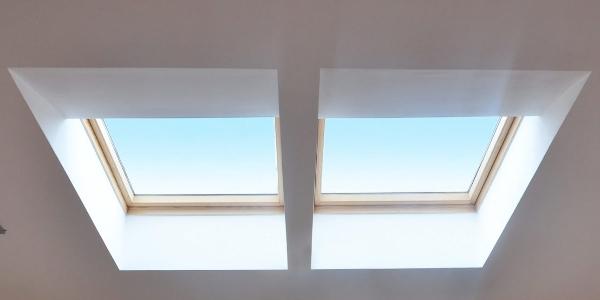
By IKO Residential.
Explore the diverse types, styles and installation methods of skylights to assist your customers when incorporating them into their roofing projects.
As a roofing contractor, one frequently overlooked application and consideration is the selling and installation of skylights. Skylights can significantly impact the ambiance and functionality of any interior space, and helping your customers select the appropriate type is critical for achieving specific objectives. Whether the aim is to enhance natural lighting, increase ceiling height or make a distinctive architectural statement, the choice of skylight plays a pivotal role.
Diving into the world of skylights, roofing contractors may initially find themselves confronted with many options. The variations include different types, styles and installation methods, along with an extensive selection of glass types, glazing, covers and shades. This guide is designed to provide professionals with a comprehensive overview to discuss skylight options with their customers.
Pros and cons of skylights
There are many advantages to skylights in general. They can make small rooms appear larger, make dark rooms brighter and ventilate humid rooms. Roof skylights can also contribute to architectural and stylistic statements.
Yet, skylights can also cause a homeowner some grief. Lower-quality skylights can cause ultraviolet (UV) damage to furniture and flooring or can create glare. All roof skylights will allow for some heat loss, as they penetrate the roof deck. In fact, skylights will release more conditioned air than even a window of the same size would. And even a properly installed skylight may sometimes lead to condensation or a leak. But there are many ways to avoid these problems, including choosing the skylight that is right for your home and making sure it is properly installed.
The three types of skylights
The first thing you need to choose is your type of skylight. Fixed and vented skylights are relatively similar, but tubular skylights offer a whole different skylight experience.
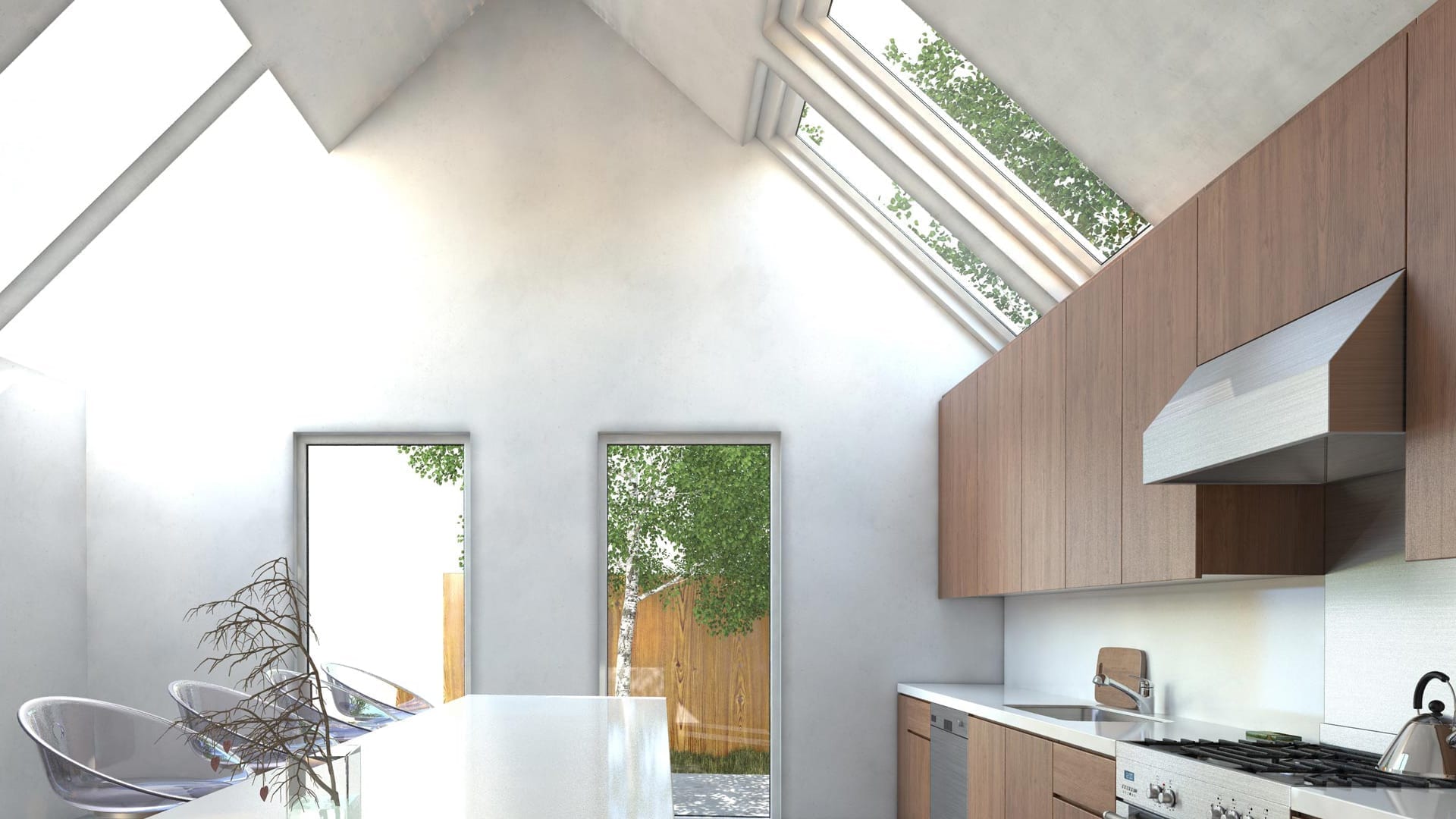
1 - Fixed skylights
These are typical skylight windows that do not open. They provide light and can provide a beautiful view of the sky or other scenery. Fixed skylights are generally installed on a high ceiling where you can’t reach them. Because they don’t open, they don’t provide humidity control for a room.
2 - Vented skylights
Vented skylights look the same as fixed skylights, but they can be opened by hand or by electronic control. Therefore, vented skylights are a good choice where condensation or excess humidity is a concern. For example, they can provide moisture control in key rooms, like bathrooms and kitchens. They may also double as emergency exits if they are easy to access and made to building codes. But vented skylights tend to be more expensive than fixed skylights.
3 - Tubular Skylights
Tubular skylights, also called solar skylights, are not traditional skylight windows. Instead, they are long tubes meant to catch and reflect light into the home. Therefore, they are good for small spaces, like bathrooms, hallways and closets. It’s also easier to install solar skylights, especially where the attic or roof is obscured by wiring or venting, because they will fit between obstructions.
Solar skylights may have dimmers to control how much light they provide. They may have exhaust fans to help with moisture control, too. And they can have a filter to keep UV light out. Tube skylights are a good choice where privacy is a top priority. Yet, they don’t provide a view outside, unlike skylight windows.
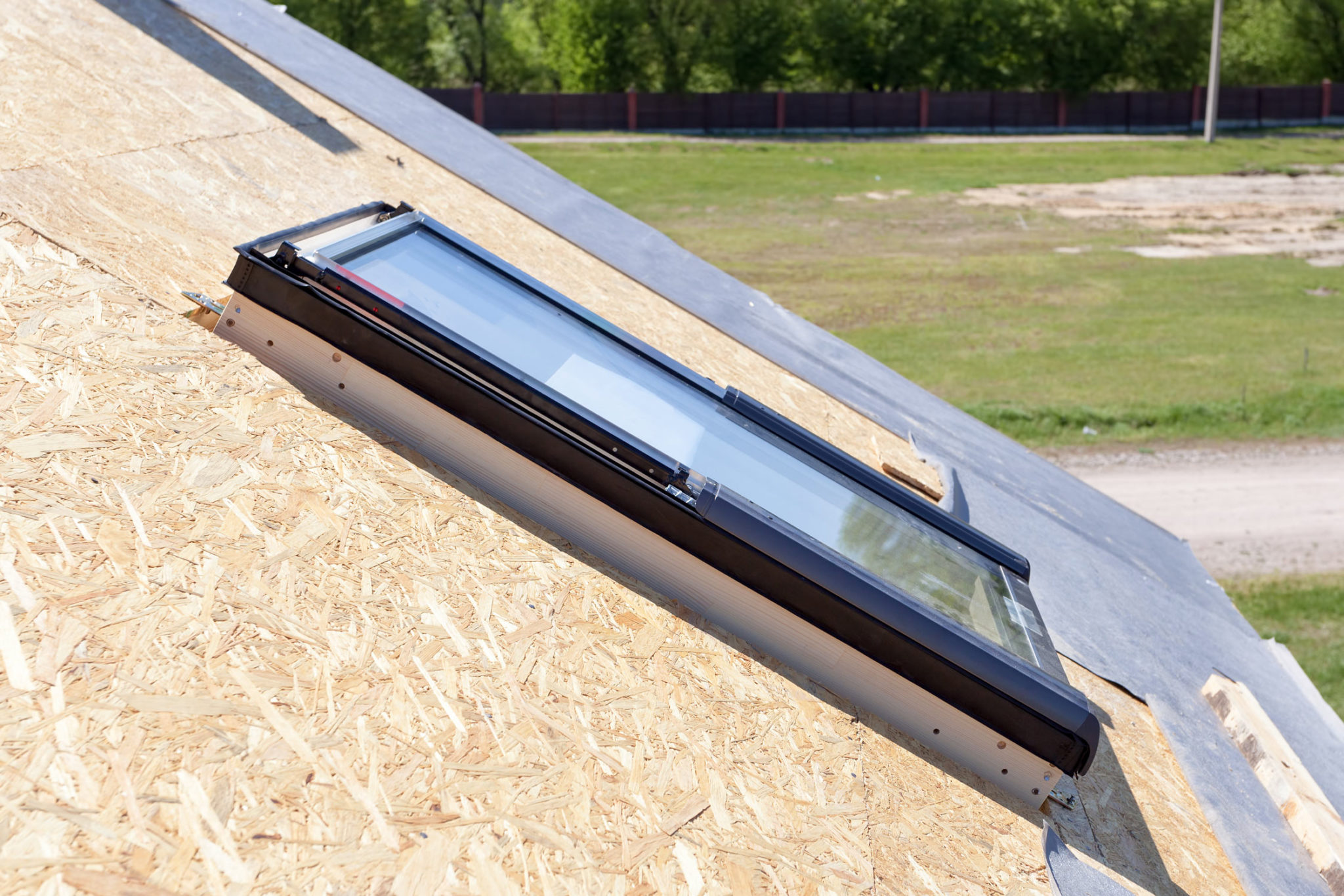
Deck-mounted versus curb-mounted skylights
While these two skylight installation methods might sound bland, they make a big impact on your finished skylight. Essentially, the difference between a curb-mounted and deck-mounted skylight is that a deck-mounted skylight sits flush with the roof, while a curb-mounted skylight is held up higher than the roof face by a curb.
Deck-mounted skylights
A deck mounted skylight’s frame is flashed directly into the roof. Skylight frames are made of extruded aluminum or galvanized steel, which must be connected to the rest of the roof by a roofing professional. It takes skill and knowledge to ensure that a deck-mounted skylight works with a roof instead of against it, so always be sure to consult with a roofing professional.
Curb-mounted skylights
Curb-mounted skylights are a superior choice to prevent leaks. They allow for more flexibility in size and can offer more glass area than a deck-mounted skylight placed in the same hole. Thus, they can be brighter, but are also more expensive.
Curbs can be built on-site or can be provided by the skylight manufacturer. In either case, a curb should be double-walled and insulated to help retain heat in the home.
The National Roofing Contractors Association recommends using curbs tall enough to allow for at least 4 inches of vertical flashing on all sides. If the skylight is installed on a low-slope roof, the curb should be even taller, to allow for 8 inches of flashing. When using manufacturer-produced curbs that aren’t tall enough, the roofing professional will have to extend the curb.
Also, the curb’s shaft can be shaped for different purposes. A straight shaft will keep the light focused in one area and can be used to highlight a specific feature of the home. For example, the skylight above is meant to highlight the bathtub.
A flared shaft is used to help disperse natural light throughout the space. An angled shaft, which can be used to capture light at a specific time of day, allows the skylight to be at a different pitch than the roof. For example, it could be angled down, on the west side of the home, to capture more light in the evening.
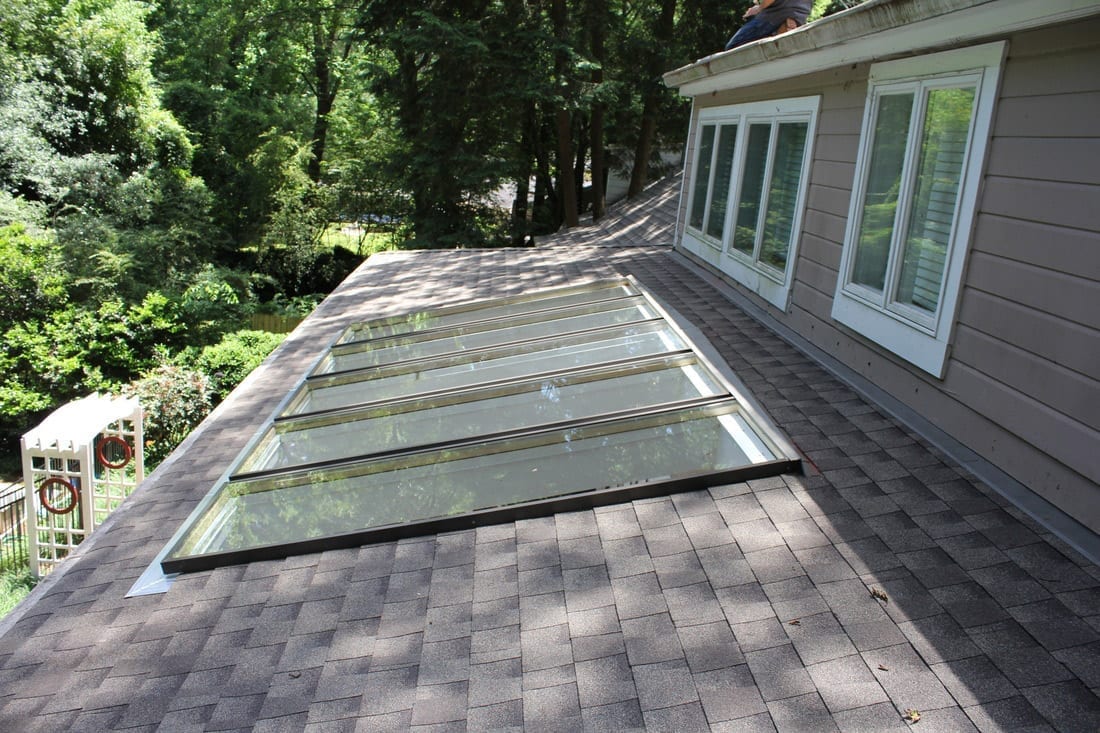
Styles of roof skylights
A skylight’s style refers to its shape and the layout of the glass. There are basic and vaulted styles. Basic styles are flat-roof skylights that do not project above the roof face unless curb-mounted. This can help you keep the look of the exterior of your home consistent. They also offer more light than vaulted styles.
In contrast, vaulted styles always project above the roof face and are typically more expensive, as they require more glass. Vaulted skylights can be a dramatic architectural feature, but if not well-chosen, they could detract from the look of your home or neighborhood.
As you consider these skylight styles, consider which ones look most pleasing to you, as well as which will fit in with the overall style of your home.
- Flat-roof skylights: These skylights are flat and follow the pitch of the roof. They may be deck-mounted so that they don’t interfere with the look of the roof line.
- Round skylights: These skylights are round, as seen from the inside of the home, but flat on the exterior. They may be deck- or curb-mounted as well. Round skylights are unusual and can look great.
- Dome skylights: These skylights project upwards in a dome. They are usually rectangular as viewed from the inside of the home but can be round too. Usually, dome skylights are acrylic (Plexiglass), which is most resistant to hail when dome shaped. The main advantage of these skylights is that they are inexpensive. Dome skylights can be used on flat roof systems.
- Straddle skylights: These roof skylights are two-pitched and placed to straddle the peak of the roof. They are almost always deck-mounted to achieve their unique look. The advantage of straddle skylights is that you get the look of a vaulted skylight on the inside, without disturbing the look of the roof line from the exterior of the home.
- Polygon skylights: These are any flat skylights of an unusual shape, like an octagon, hexagon, triangle or specialty shape. You can achieve a very dramatic look with polygon skylights.
- Pyramid skylights: The classic vaulted skylights, they have a square or rectangular base and project upwards to form a pyramid shape. The glass panels meet at the hip. Pyramid skylights make an architectural statement, but they usually capture less light than a basic skylight of the same size.
Pyramid and other kinds of vaulted skylights may, instead of forming a point, form a ridge or flat top. From the inside, there is not much difference between pointed and flat-top pyramid skylights; but, from the outside, one shape or the other might look better on your home.
- Roof lantern/conservatory skylights: Before skylights, roof lanterns were used to bring light into a home or other building. They consisted of a square projecting up from the roof, with windows installed on all sides, and a normal roof above.
Now, roof lanterns can be made with a glass top to provide a unique look and even more light. Still, they look best on historical home styles.
- Vaulted polygon skylights: These skylights have a vaulted style, but with an octagonal, hexagonal or another unique base shape.
- Barrel vault skylights: These are vaulted roof skylights, which, instead of projecting up to create a peak, are topped with curved glass. Each end must have a half-circle glass piece on each end to support the curved glass. This creates the look of a barrel. Quarter vaulted skylights are very similar but have a quarter circle glass for their end pieces.
All kinds of skylights may be placed in tandem, or in a single-file row, with no roof space between them. Of course, you could achieve almost the same look by installing skylights next to one another with enough room for a rafter between them. Or you may place multiple roof skylights in a cluster pattern.
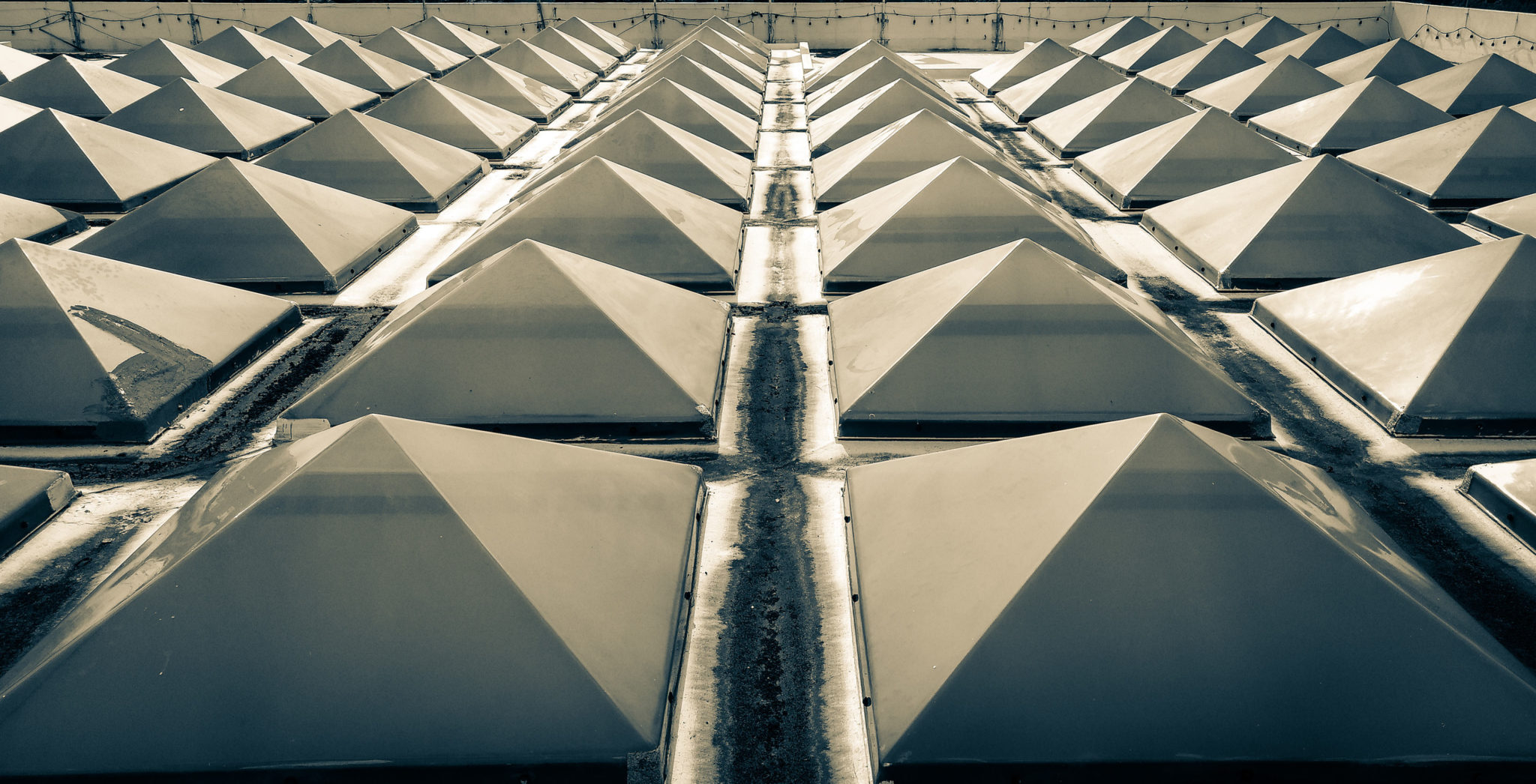
Types of roof skylight glass
Your choice of skylight glass will determine how durable your skylight is. Each type of glass can have features and treatments to keep out UV light, insulate better and generally improve performance. We’ll discuss these features after a quick explanation of the types of glass.
- Plexiglass: This is not a form of glass but acrylic and polyglass. It is a sturdy and lightweight material that you may want to consider because it is so inexpensive; but it has drawbacks. Acrylic will scratch if debris or hail hits it. It allows in more UV rays than other skylight materials, and these rays are the main culprit behind faded furniture and flooring. This same UV exposure will wear down the acrylic itself, which may eventually crack. Over time, acrylic may also yellow, distorting the light and view out of your skylight.
- Tempered skylight glass: Tempered glass is scratch-resistant and heat-treated for strength. But, if it does break, it shatters into a thousand virtually harmless granules. By not creating large shards, tempered glass is safer. It also insulates from noise better than acrylic.
- Laminated skylight glass: Laminated glass has a thin layer of either polyvinyl butyral (PVB) or ethylene-vinyl acetate (EVA) sandwiched in between two layers of tempered glass. Thus, if the glass breaks, the granules from the tempered glass tend to hold onto the center layer, reducing the chances of tempered glass pieces falling into the home. Most high-quality skylights will have laminated glass, but it is generally the most expensive option.
All these skylight materials may be single-, double- or triple-pane thick. Sometimes this allows for unique features, like gas insulation.
Glass features
- Gas filling: Between two layers of glass, a manufacturer can insert an inert glass that helps with insulation. Krypton and argon are two typical gases used for the purpose. Argon insulates better but is more expensive than krypton. Xenon gas filling is possible but is normally used only in commercial glass. R-value measures a skylight’s insulation, the higher, the better.
- Low-E coatings: These coatings add energy efficiency without obscuring the glass (unlike some glazing). U-value measures how much heat passes through the skylight and will allow you to compare the energy efficiency of different skylight windows. The lower the U-value, the less heat moves through the glass.
- Glazing: There are various types of glazing, which can shade out skylights where glare is a problem. The types of glazing available will vary by manufacturer, but the darker the glazing, the less light will be allowed in. The shading coefficient measures how much light is allowed through the skylight; the lower the value, the less light the skylight allows through and the more shade it provides.
Other kinds of coatings may be designed to reduce noise, condensation and UV rays. A skylight manufacturer can layer many of these coatings. Often, UV rays are a primary concern for homeowners because exposure to these rays dulls furniture and flooring over time. If you know the UV blockage value of the glass (a percentage of UVA rays that is blocked), you can compare different coatings.
Skylights and hail damage
While glass manufacturers continue to make advances in impact resistance, hail remains a challenge. Plexiglass is the worst choice when it comes to hail resistance, as it may scratch and will break much easier than glass. Tempered and laminated glass resists small and medium hail quite well, but there is always the possibility of abnormally large hail breaking through a roof skylight. When that happens, skylight repair or replacement are your only options.
But skylight repair doesn’t have to be expensive. Some skylight manufacturers offer warranties that cover hail damage, and home insurance can provide you with an additional layer of protection.
You can also use exterior skylight covers to protect skylights from hail. For example, wire cages may defend acrylic skylights, though they may spoil the view. It is ideal to have the covers or shades produced by the manufacturer so that they won’t void the overall warranty on the product.
Skylight covers and cages
Acrylic skylights can benefit from external wire cages to prevent hail damage and are useful as general safety features.
Instead of preventing damage, other skylight covers are designed to limit glare or UV rays. These covers can be made from a variety of fabrics and are wrapped over the outside of the skylight. They are best for homeowners who permanently want the covers on because you must call in a professional to put them on and take them off.
If you want to be able to adjust the covers, skylight shades and blinds are your answer. They are for the interior of the skylight, just like on a window, but they may be operated by a motor instead of just by hand. Unlike wire cages and most skylight screens, skylight shades and blinds can offer complete privacy too. But they will not help protect the exterior of the skylight from damage.
Depending on the manufacturer you choose for your skylight blinds, you will have a wide variety of colors and materials to choose from.
Roof skylight condensation
Skylight condensation can occur between layers of glass or on the surface of the skylight. It appears as small droplets of water, which can disrupt your home and cause damage. Because condensation is caused or worsened by a home with excess humidity, running a dehumidifier, circulating air by installing a fan or simply opening a skylight vent can all help solve the problem.
Poor quality glass and cold climates may also cause or worsen condensation. In either case, the glass is too cold as compared to the inside temperature, and air vapors naturally collect and liquefy on the glass. Replacing the skylight with glass that has a high R-value, or with a skylight that has condensation gutters, is the only solution.
If condensation appears between layers of glass, it may be a sign that the seal has broken and will need to be fixed. While some homeowners may be tempted to try to seal up the skylight with caulking, that’s not an ideal solution. If the seal isn’t restored to proper working order, the condensation could begin to leak into the roof structure, causing further damage. Instead, you should contact a roofing professional who can examine the source of the condensation and provide a long-term solution.
Roof skylight leaks
Sometimes, condensation might be a leak. Unfortunately, many who specialize in skylights do not understand the function of a roof the way that a certified IKO roofing professional does. That’s why you should always have a roofing professional install at least the flashing around the skylight, but preferably the whole skylight. Be sure to choose your roofing contractor carefully.
Do skylights increase home value?
While roof skylights usually increase home value, whether they are the right investment for your house depends on several factors. If quality skylights are installed professionally, potential buyers will view your skylight as an asset. If a skylight already has problems by the time you go to sell your home, it will be a liability.
According to Consumer Affairs, installing skylights is usually less expensive than many other home upgrades you might invest in, like installing a deck and changing your countertops, cabinets or flooring in the kitchen. But there are things homeowners can do to mitigate the cost of their skylight.
Americans can take advantage of a federal tax credit, which applies to solar skylights. The tax credit has recently been extended to apply through 2021. The manufacturer will have to confirm if your choice qualifies for the program but look for skylights with a solar-powered component, like blinds or venting. Keep your receipt, (and a copy of the manufacturer’s guarantee), and submit it with IRS tax form 5695 to get a 30 percent tax credit.
Another cost-saving factor is to choose multiple smaller skylights, which fit in between a roof’s rafters and purlins, instead of making structural changes to the roof to allow for a single large skylight. Dome skylights are particularly inexpensive and look great in pairs. Multiple roof skylights can create a lovely symmetrical look, as below.
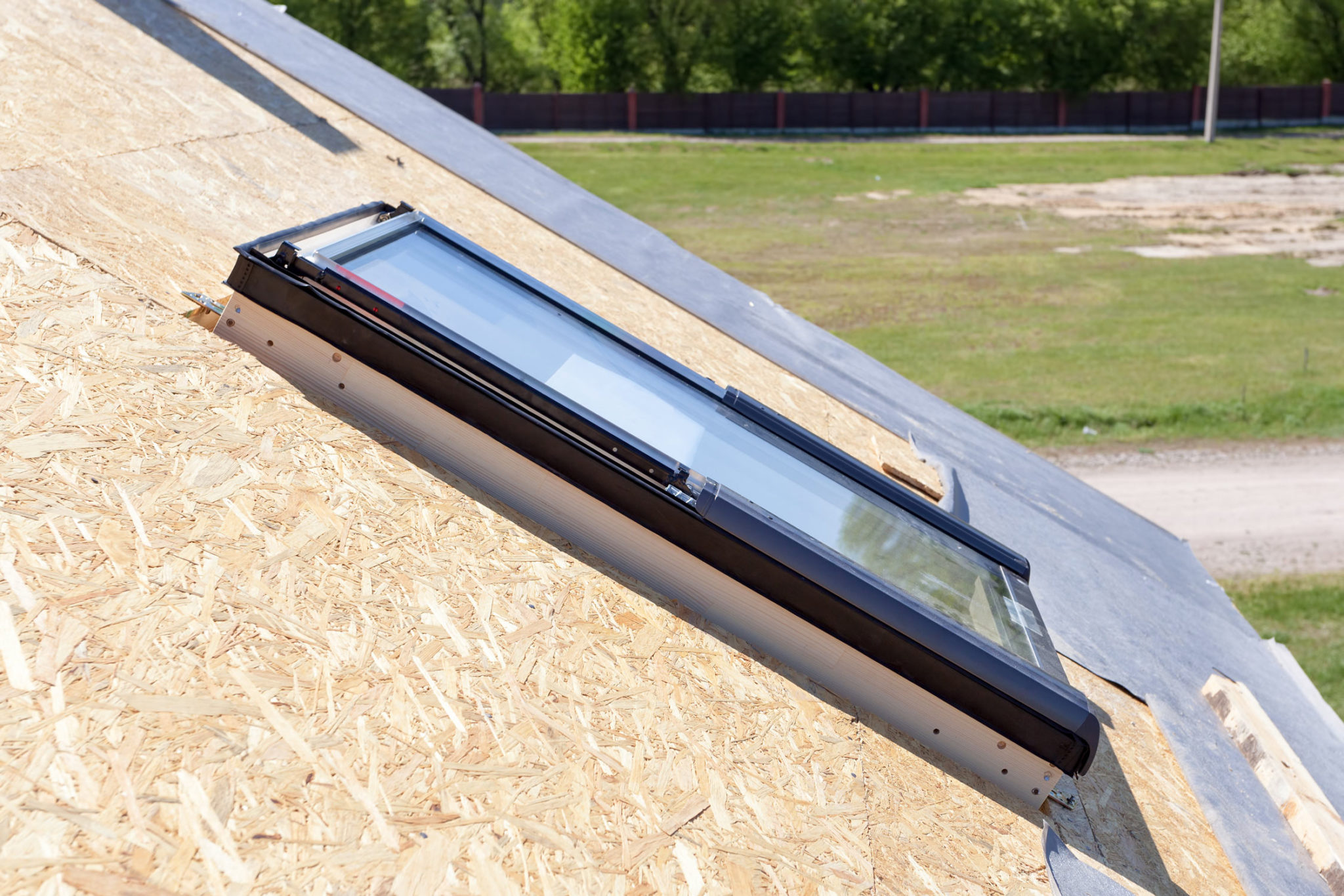
Indeed, whether skylights will increase a home’s value also depends on its look and whether potential buyers like that look. Vaulted skylights make a grander statement and are therefore bigger risks than flat-roof skylights. The least risky option is a solar tube skylight because it adds natural light without dramatically changing the scope of a room. And everyone loves natural light.
Original article source: IKO
Learn more about IKO in their Coffee Shop Directory or visit www.iko.com/na/.





















Comments
Leave a Reply
Have an account? Login to leave a comment!
Sign In